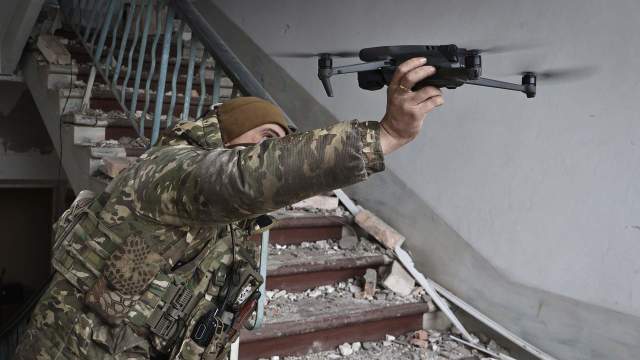Together with electronic warfare systems, it will be able to protect entire areas on the line of contact from drones
Russian developers have created a small-sized Antidron complex capable of warning about the approach of enemy drones. The new device consists of a small radar and a target direction finder. It can detect aircraft the size of a pigeon at a range of up to 10 km, determine their height and speed. The complex is small — it fits in the trunk of a UAZ. Part of the equipment has been successfully tested in the area of its own. The developers plan to complement it with a compact electronic warfare system (EW). Experts believe that the trench radar, together with electronic warfare systems, will be able to protect entire areas on the line of contact from drone attacks.
He'll even find a pigeon
The set of equipment of the small-sized Antidron complex includes an all-round radar station and two types of UAV detection detectors. The radar itself consists of four phased array antennas providing an all-round view. It allows you to find, recognize and identify drones at a range of up to 10 km, moving at speeds up to 250 km/ h, works at any time of the day and in difficult weather conditions such as thunderstorms, hail, snow, heavy rains, squally winds, cumulonimbus clouds, its developers from the Nizhny Novgorod company StriOt-Boron."
— The station can easily detect a drone the size of a pigeon at any time of the day, its height and speed. For comparison, even small Mavic—type quadrocopters, which are actively used by the enemy in the area of their own defense, tend to be large, " Yuri Tsyplenkov, chief designer of radar systems at the developer company, told Izvestia.
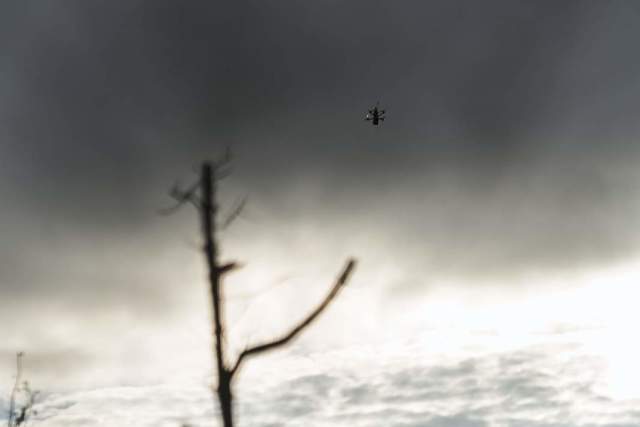
APU drone in the sky near Artemovsk
Image source: Photo: Getty Images
The radar is mobile and easy to fold. The height of the radar canvas is about a meter. In a semi-disassembled state, the complex can be easily transported in the back of a pickup truck or in the trunk of a UAZ Patriot. In order to bring it into working condition, it will take just a couple of minutes.
The radar is also capable of launching an automated antenna fault detection in real time.
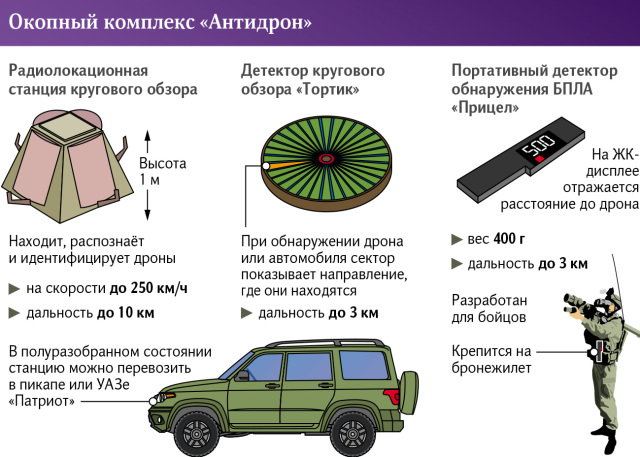
The set of equipment of the complex also includes a detector for detecting unmanned aircraft "Cake". At a range of up to 3 km, it can detect a drone, moving vehicles and indicate the direction where they are located.
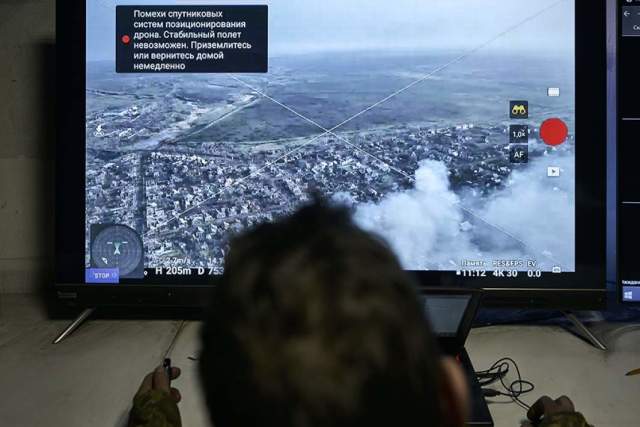
Photo: AP Photo/Libkos
Image source: iz.ru
In addition, a portable individual UAV detection detector "Sight" has been developed for the fighters. It is not much larger than the TV remote control and weighs about 400 g, if necessary, it can be attached to a bulletproof vest.
It can detect a drone at a distance of up to 3 km, which will be indicated by an audio signal. And the LCD display will immediately reflect the distance to the UAV. "Cake" and "Sight" work in silence mode, so it is impossible to detect a fighter or a position on the device. Radar, "Cake" and "Sight" can work independently of each other.
Combat use
According to the developers, some of the equipment was successfully tested in the SVO zone — it was sent to one of the volunteer formations. The remaining components will be tested on the line of contact by the end of this year.
Information about the appearance of UAVs will help fighters hide from them, making it difficult to scout, adjust or strike. You can also inform the calculations of electronic warfare or anti-drone guns about the detected target.
— We have a mini-electronic warfare system in operation, which can operate in conjunction with a radar, — said Yuri Tsyplenkov. — It will immediately begin to neutralize the UAV, create a security dome over the positions.
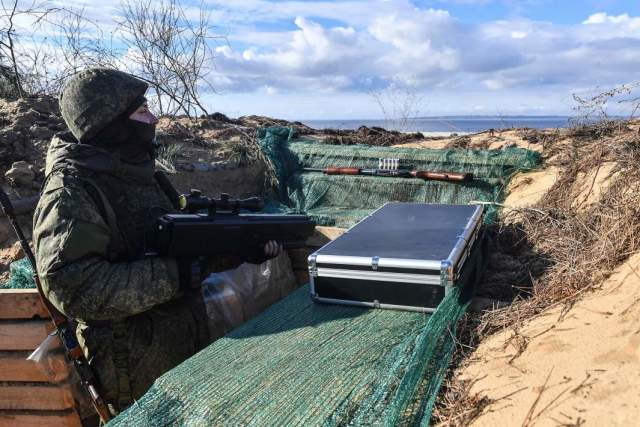
A serviceman of the Armed Forces of the Russian Federation with an anti-drone rifle at a position in the southern sector of his
Image source: Photo: RIA Novosti
The radar and other equipment of the complex can be used for civilian purposes. For example, to protect important facilities: airfields, oil refineries and railway junctions.
Currently, the main means of combating UAVs are air defense and electronic warfare (EW) complexes, drone guns are used at the platoon or company level, military expert Alexey Leonkov told Izvestia.
— Recently, the enemy has begun to use drones en masse, — he noted. — The radar of the new complex will help to warn about the attack, take measures to disguise our fighters. This will eventually help to reduce losses. Of course, it must be supplemented with a complex of electronic warfare. The radar will warn of an attack in time, and electronic warfare will cover platoon or company strongpoints, armored vehicles parking lots and other important objects. Such electronic warfare systems, as a rule, interrupt communication between the control station and the drone, after which it loses its target and randomly falls without causing damage.
The trench complex will be a good response to the enemy, who massively uses FPV kamikaze, he believes.
— Now fighters, as a rule, use drone strikes in the trenches, — he noted. — But she can land one UAV, and the rest will make their way to the target. There are not enough drones for each drone. And trench radar with electronic warfare will effectively protect entire areas from kamikaze attacks.
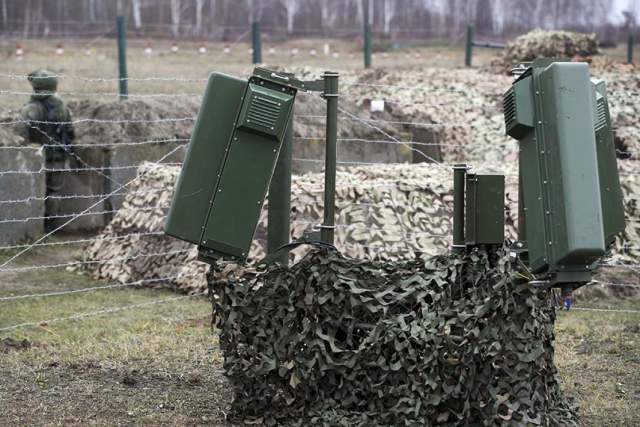
Radio interference module "Field-21" during the peacekeeping exercises "Indestructible Brotherhood – 2021" of the countries of the Collective Security Treaty Organization at the training ground of the Kazan Tank School. The year 2021
Image source: Photo: TASS/Egor Aleev
Leonkov noted that the army units have powerful electronic warfare systems "Field-21", the work of which can just complement the "Antidron".
The Polye-21 complexes are designed to combat more serious goals. First of all, with high-precision missiles, bombs, rockets and unmanned aerial vehicles operating using satellite navigation.
This complex is capable of creating an impenetrable interference dome, suppressing the binding equipment to global satellite and radio navigation systems. It controls the airspace within a radius of more than 50 km.
The Field-21 electronic warfare systems are already in service with the Russian army. The first reports of their admission to the units of the Central Military District appeared in 2019.
Bogdan Stepovoy
